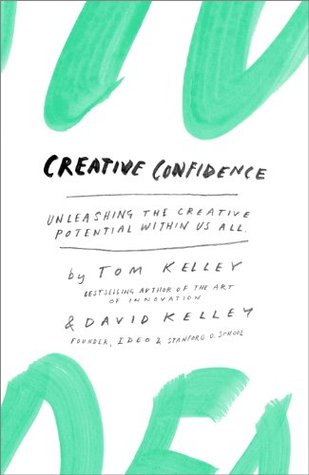More on this book
Community
Kindle Notes & Highlights
Read between
June 21 - September 16, 2019
At its core, creative confidence is about believing in your ability to create change in the world around you.
We think of creativity as using your imagination to create something new in the world.
That combination of thought and action defines creative confidence: the ability to come up with new ideas and the courage to try them out.
Creative confidence is an inherently optimistic way of looking at what’s possible.
Design thinking relies on the natural—and coachable—human ability to be intuitive, to recognize patterns, and to construct ideas that are emotionally meaningful as well as functional.
In other words, those under the influence of a fixed mindset were willing to sabotage their long-term chances for success rather than expose a potential weakness.
Start with a growth mindset, the deep-seated belief that your true potential is still unknown. That you are not limited to only what you have been able to do before.
The process of guided mastery draws on the power of firsthand experience to remove false beliefs.
“Failure sucks, but instructs.”
“success has many fathers, but failure is an orphan.”
“We’re now running national education systems where mistakes are the worst thing you can make,”
“Education is the system that’s supposed to develop our natural abilities and enable us to make our way in the world. Instead, it is stifling the individual talents and abilities of too many students and killing their motivation to learn.”
More than a century ago, poet and essayist Ralph Waldo Emerson urged us to “do the thing you fear, and the death of fear is certain.”
“Courage is only the accumulation of small steps.”
I wanted to devote the best years of my life to doing something meaningful.”
As Nobel laureate Linus Pauling famously said, “If you want a good idea, start with a lot of ideas.”
As the American writer Mark Twain said a century ago, “It’s not what you don’t know that gets you into trouble, it’s what you know for sure that ain’t so.”
Rolf Faste, the former director of the product design program at Stanford for twenty years, used to say, “If a problem is not worth solving, it’s not worth solving well.”
French chemist Louis Pasteur famously asserted 160 years ago that “chance favors the trained mind.”
From penicillin to pacemakers, and from saccharin to safety glass, a lot of discoveries have come into this world because scientists noticed that one of their mishaps or mistakes had turned into a breakthrough.
Nurture the kind of “prepared mind” that seizes the moment when an epiphany occurs.
The first step toward being creative is often simply to go beyond being a passive observer and to translate thoughts into deeds.
Instead of just complaining, ask yourself, “How might I improve this situation?”
It’s hard to be “best” right away, so commit to rapid and continuous improvements.
Money will always be easier to measure, which is why it takes a little extra effort to value the heart.
Once you start to think about your life and career as just another creative challenge, many different possibilities may come to light.
Keep your sense of humor • Build on the energy of others • Minimize hierarchy • Value team camaraderie and trust • Defer judgment—at
When we disagree with someone else’s idea, we push ourselves to ask, “What would make it better? What can I add to make it a great idea?” Or, “What new idea does that spur?”
Be intentional about choosing actions you can take right now that might add more joy and meaning to your own life—and the lives of the people around you.
Tim Brown writes, “Think of today as a prototype. What would you change?”
When a movie is over and the credits roll, we are always amazed at how many hands have touched a major film production.


